Motto | |||||||
| Anthem | "Kalistan, Kalistan!" | ||||||
| Capital (and largest city) |
Kaliburg | ||||||
| Other cities | Vrassa - Port Sweedes, Funkadelphia, Senvias, Vrassa City
Neveras - Neveras City, Bongjing (High Bong), Vilbin, Lhasa Odufaray - Eshar, Port Redbeard, Genderis, Kluptoon Suldanor - Sulari, Yoshimi, Dana, Bisstec Ananto - Luxon, Dulnerstaad, Dahriel, Everari | ||||||
| Language official |
Vrassan,Egelian | ||||||
| others | Enskalan | ||||||
| Religion main |
81% Hosian •74% Brethrenist •4% Aurorian •4%Septentrine | ||||||
| others | •10% Irreligious •3% Yeudi •2% Ahmadi •2% Daenism •2% Other Other religion | ||||||
| Ethnic Group | Kalistani Cultural Influences in Kalistani | ||||||
| Demonym | Kalistani | ||||||
| Government | Unitary parliamentary republic | ||||||
| Premier of the Republic | |||||||
| Legislature | National Assembly | ||||||
| Area | 1,412,400 km² | ||||||
| Population | 87,932,423 (4774) | ||||||
| GDP Total: |
2,808,407,000,000 KRB (4386) 1,221,000,000,000 KAL | ||||||
| per capita | 31,938 KRB (4774) 13,885 KAL | ||||||
| Established | 4287 (current Republic) May 1, 4772 (Restored Republic) | ||||||
| Currency | Kalistani Ruble (KRB) | ||||||
| Time Zone | GMT +6 | ||||||
| summer | GMT +6 | ||||||
| Drives on the | Left | ||||||
| Calling Code | +21 | ||||||
| Internet TLD | .ks | ||||||
| Organizations | World Congress, North Seleyan Economic Community, Organization of Drug Exporting Nations | ||||||
Kalistan, officially the Republic of Kalistan (Egel.: Republica de Kalistan) is a unitary parliamentary republic in north-eastern Seleya. It shares a border with Lodamun to the west and Baltusia to the south. Kalistan comprises a total area of 1.41 million km² and has a population of around 99.7 million people. Since ancient times, Kalistan has been a unique nation within the continent and the globe due to its reputation as a safe haven for refugees of all varieties. At times this has created international tension due to exploitation by criminals and pirates. In modern times, Kalistan has been an important international player although it has struggled to retain the economic and cultural development which characterized the country's "Age of Affluence".
Etymology
The name "Kalistan" is derived from the name of the Kalii tribes. Kali was a blanket term used to refer to various native peoples of northeastern Seleya, particularly mainland Kalistan, Athosia, and parts of Norstavan. Until the foundation of Kalistan as a federal republic in 1924, it referred exclusively to the mainland region of the country and not to the island of Ananto. In addition, the Aldegarian suffix -stān, meaning "place of" or "country" is used. This is relatively common for names in regions with historic Aldegarian influence, for example "Kafuristan and Kalkalistan.
History
Kalistan emerged from legendary prehistory around the year 2000. At this time, Kalistan considered itself an empire, ruled from Ananto, where nobles who adopted names and titles jostled with one another for influence in the court of the Floob, or Emperor of Kalistan. While Kalistan was nominally a Republic at this time, the Floobs still had great influence over the government of Kalistan. Kalistan remained a Republic until 2181, when the empire was restored. That imperial period lasted, either nominally or in fact until the Empire was officially abolished on August 31 4056, and all historically titles and claims were officially vacated.
Kalistan's history has been marked by interminable conflicts between the Left and the Right. Conservatives in Kalistan have always supported stronger police forces, fewer civil liberties for citizens and less government involvement in the economy, while the Left has generally adopted civil libertarianism for the people and socialism and Nationalism for the economy. The Government has most often been dominated by Leftist Parties, during which time, there is profound civil tranquility in society, but occasionally a rightist Party gains control and a period of turbulence that occasionally turns violent ensures.
From 2900 on, the dominant ruling Party has been the Socialist Party of Kalistan. The SPoK has been at the center of most historical events in Kalistan's history, from the various eras of one Party rule, to Kalistan's recent Golden Age. The Socialist Party has participated in two civil wars with Rightists, as well as a number of interventions overseas. Socialist Partisans helped defend the Island of Ananto during the Ananto War. In many ways, the history of Kalistan is the History of the fortunes of the Socialist Party and the legacy it left as it occasionally went defunct.
The 3000s saw dramatic improvement in Kalistani economy and power. It all culminated in the Kalistani Age of Affluence beginning around 3912, when the tenets of Ethical Socialism became the prevailing ideas in the Government and Society of Kalistan.

Premier of the Republic, Omar Al-Khali was a leading figure during the Kalistani Age of Affluence
This era was seen as the pinnacle of Kalistani influence in world affairs, from military and economic matters (This era spanned the entire War with the Empire of Indrala) to diplomacy (Kalistan was elected to the first Several Security Councils of the World Congress), to culture, music, and religion. This age was closely tied to the one-Party state under the Socialist Party and later under the Socialist and Labour Alliance. The Age of Affluence is traditionally held to have ended with the Passage of the end of One Party rule in 4117.
Since 4400, Kalistan has once more been reasserting itself on the Selayan stage, after another period of isolation and entropy, which saw most of Kalistan's great institutions fall to rust and decay under various governments who neither knew, nor particularly cared about Kalistan's great past. A brief conflict over the closing of the Ananto Strait led to a return of Kalistan to international prominence.
In the 45th Century, a political Party aiming to elevate the status of a discovered culture, known as the Enskalan, aimed to remake Kalistan as the first and only Enskalan Republic. Between 4735 and 4770, the official language and all governmental titles were in Enskalan. But during the end of this period, following an occupation from Lourenne in 4759, The Socialist Party of Kalistan oversaw the transition back to the more traditional cultural, linguistic and political arrangements which have existed for most of Kalistan's history. Kalistan celebrated independence and Restored Sovereignty on May 1, 4772, and the date has been listed as the Independence Day for the Restored Republic.
Geography
The Geography of Kalistan is varied. The most mountainous region of Kalistan is Neveras District, which is bordered by the Neveras Range to the West, and contains several important river valleys, including the Neveras River. The Odufar Ridge separates Neveras from Odufaray and Suldanor, and beyond that, both provinces are fairly flat coastal plains, which allows for extensive agriculture. The fourth province of Mainland Kalistan, Vrassa, is a mix of both types of landscapes, and is generally widely populated, with most citizens living in the major cities, allowing for survival of the largest forests of mixed conifer and deciduous flora. The more mountainous areas, toward the Lodamese border are very wild and sparely populated.
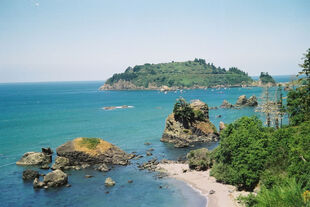
Xanadu Coastline, Ananto
The Island of Ananto is very mountainous, but the mountains are not as high or dramatic as those on the mainland. Most of the mountains are at the center of the heart shaped Island, and form a T shaped spine that divides the island up into three main regions: The Kali Plain, which contains the capital Kaliburg, and extends along the foothills of the Xanadu and Constipated Ranges from Dulnerstaad in the north to Luxon in the south. This region is the most densely populated are in Kalistan, and contains 17% of the nation's entire population.
North of the Constipated and Angry ranges is the Eveari Enclave, which consists of the Bluegrass Delta and the City of Eveari, and which was Kalistan's primary Blue Water port before the Ananto War.
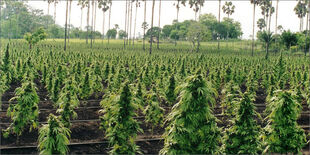
ODEN Marijuana plantation in the Dah Delta, Ananto
The East of the Angry and Xanadu Mountains sits the Dah Delta, a huge swampy area that is extremely flat and lowlying, and which even minor storms can inundate entire to a distance of several miles. The rest of the region sits slightly higher than sea level and is known as the Great Green Plain. This area is exceptionally suited for agriculture and is almost entirely given over to the cultivation of marijuana.
Climate
Kalistan is blessed with a fairly wide variety of climates. On the Eastern half of Ananto, especially, an humid sub-tropical climate exists with hot, humid summers and warm, rainy winters, due to the Warm Dovani Current. Meanwhile, the climate of the western side of the Island is generally mild and rainy in the summer and cold and rainy in the Winter, despite the latitude of Ananto just north of the Tropics. The reason for the more temperate climate is the Keris Drift which comes from the north pole and through the Anantonese Ocean north of Kalistan. The Odufar cutoff flows through the Ananto Strait, and cools both Western Ananto and Mainland Kalistan.
Vrassa and northern Odufaray are heavily influenced by the Odufar cutoff, and have a cooler wetter climate than the rest of Mainland Kalistan. In addition, in the winters, Vrassa is more influenced by the continental climate generated by Selayan geography, and they experience deep snows in Western Areas. Odufaray is more moderate, and Southern Odufaray is able to sustain agriculture year round. Suldanor is certainly subtropical, and frequently experiences dense fog along the coasts as the colder water interacts with warm air blowing up from the south. Suldanor experiences hot summers and moderate winters, as well as wet and dry monsoon seasons.
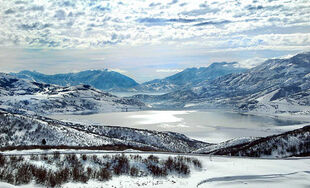
Bong Valley, Neveras, in Winter
Neveras is largely mountainous, and has a dry, continental climate. It is protected from the South from rains by the Odufar Ridge, and receives rainfall and snow from the North and West. Neveras generally has cool summers and cold winters, and most moisture it receives occurs in the Fall and Winter. Very little agriculture can be supported in Neveras, though there is some farming in Neveras' valleys and in the Bong Basin.
Government and politics
Government
Executive
Kalistan's head of state is the President of the Republic. A largely ceremonial figure, the President is expected to fulfill certain constitutional responsibilities and symbolizes the unity and legitimacy of the Kalistan political system. Among the most important duties of the President are nominating individuals to the cabinet and convening the Constitutional Court.
Legislature
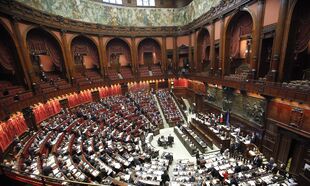
National Assembly of Deputies of Kalistan
Kalistan's legislative branch is known as the National Assembly of Deputies of Kalistan. The National Assembly of Kalistani Deputies consists most often of the Lower House, also known simply as the National Assembly, though, as per The Kalistani Law: Upper House the President may, from time to time, convene a second house, known as the Assembly of Advisors to serve as an advisory panel. To date, the Assembly of Advisors has never been convened
The National Assembly is made up 750 Deputies elected from population-based districts. In addition to law making, the Assembly has the ability to call for early elections, if a large vacancy of seats develops or a vote of no confidence passes against the Premier of the Republic. The National Assembly also approves or rejects Cabinet bills, tax and spending bills (which are made exclusively by the Minister of Finance: All other proposals are illegal and must be voted down) and ratifies treaties proposed by the Foreign Minister.
As center of the politics of Kalistan, the Chamber of Deputies ratifies, by majority the President's nomination for Head of Government, called Premier of the Republic, and his or her Government. Any Party may veto the proposal by being included in the proposal and not voting for it (either with a no vote or an abstention.) Historically, according to the Principle of Separation of Powers, the Premier is selected from the Largest non-Presidential Party, though this rule is only slightly amended during periods of highly partisan coalition politics when the Largest non-Presidential Party is Hostile to the Preident's majority coalition.
Judiciary
The Kalistani Judicial system has adopted a hybrid system of limited Common Law and Code law. On the one hand, the Courts celebrate the presumption of innocence and the burden of proof is always on the Prosecution, except in cases of appeals. Jury trials are an absolute guarantee, and the independence of the Judiciary is taken for granted. But on the other hand, the court is only used to try individuals for whom there is a preponderance of evidence, so there are few technicalities to escape legal justice with. Most Kalistani citizens who have not actually committed the crimes that they are charged with have ever seen the inside of a Kalistani Court room. There is a very limited use of tort and civil law in Kalistan, with most civil matters handled by the Bureaucracy or outside the courts. Court hearings are not adversarial.
As of the passage of the Prison Abolition Act in 4077, prisons have been abolished in Kalistan.
In Kalistan there is a two tiered court system, with most cases being resolved at the local/District level, and the National Court being the primary Court of Appeal. The Court System is absolutely independent of the political branches of Government, and handle their own hiring of judges and adjudication of the law.
Kalistan does maintain a judicial check on the political branches. This takes the form of the Kalistani Constitutional Court. The Constitutional Court's is convened and seated by the President of the Republic- at a time of his/her choosing. The primary role of the Court is arbitration on Constitutional and RP matters within Kalistan. For example, a controversy about some Party acting extra-legally may arise and necessitate the convention of the Constitutional Court.
The debate over the matter occurs between counsel for each Party to the controversy, and amicus briefs may be filed by other entities. The Court then votes, with each Justice receiving one vote, with the exception of the Chief Justice, who will only vote to break a tie. The decision in the arbitration is final, and becomes canon law which must be observed by all.
The following formula is used to calculate the seatings.
- Any party which holds a seat in the National Assembly receives one seat
- A party which holds the Presidency of the Republic receives an additional seat
- A party which holds the Ministry of Justice receives an additional seat- who serves as Chief Justice and only votes in the case of a tie.
- A party which holds the plurality, if they do not hold either of the above offices receives an additional seat
The court's justices usually serve terms twice as long as the Assembly Deputies or the President.
The Constitutional Court has only been convened rarely.
Local government
As per the District Government Act of 4054/80, in addition to the presidential and legislature elections, elections are also held for District Government positions. District Governors are named by the party receiving the most votes in that District, and District Assemblies reflect the electoral results for that District in the General Election. District Speakers, chosen from the plurality too, control the Agenda in their respective District Assemblies.
Politics and elections
Kalistan's political history has consistently played out in terms of a struggle between populist neo-fascism and proponents of Ethical Socialism, in which the latter tends to emerge victorious.
There have been large periods of Kalistan's history when the country was nominally a one Party State. One Party States represent both an opportunity and a challenge for the Kalistani political system and frequently allow both the law to stagnate, and create a dramatic warping of Kalistani reality in the direction of the single Party's ideology. One Party rule regularly gives way to frequent, violent, but ephemeral reaction, as most Parties which have risen in Kalistan have followed a meteoric course into Power, with a sudden rise propelled almost exclusively by reaction, and then a just as sudden disappearance into oblivion. Most Parties which have followed this course have been reactionary, fascist or parochial nationalist Parties who rose in reaction to the dominant Socialist Ideology of the nation.
Administrative divisions
Kalistan is split into five districts. The capital District, Ananto, is also the most populated, the most politically influential, and the most culturally progressive, while Vrassa, in the north of the country, tends to support conservative causes and Parties most often. Neveras is the most rustic of the Districts, while Suldanor tends to be the most heavily industrialized District. Odufaray is home to important National assets, as well as a center of transportation, agriculture, and industrial production.
Foreign relations
For centuries Kalistan retained a primarily isolationist foreign policy but following the initial dissolution of the SP, a number of treaties were signed with nations- especially in Seleya and Dovani. Kalistan was formally absorbed into the United Kingdom of Louernne between 4759 and 4772, where the Lourenne Monarch was the official Head of State of the Republic, and foreign policy was vested in the Crown.
Military
The President of the Republic is the head in the Kalistani Regular Forces, which consists of Army, Navy and Air Force. Historically, partisan militias have played an important role in the Kalistani armed forces, and currently serve as irregular auxiliaries to the Regular Force.
Economy
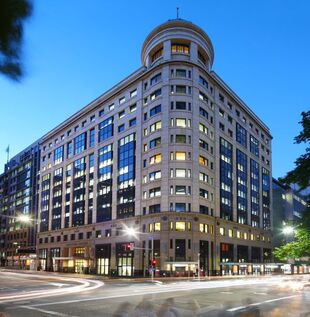
The Kalsie, Kalistan's Stock Exchange, Downtown Kaliburg
Kalistan has a powerful economy, based largely on investment and service industries. Kalistan is listed as a "Middle" Economy, meaning it relies on export-based manufacturing, heavy industry, and trade. The Kalistani economy also features a large, specialized agricultural sector. Kalistan is famous for being located in the Drug Belt of Seleya, and is one of the top producers of high quality cannabis, raw opium, hashish, and coca, and is also a center for drug refining and synthetic drug manufacture. In addition, Suldanor District boasts the world's largest treacle mining sector, which gives Kalistan the world's largest share of treacle production. Kalistani is also known for exporting large amounts of petroleum products, alcohol, and iron and steel due to developments in the economy following the year 4000.
The Kalistani Economy was once dominated by three major conglomerates, known as the Big Three: Kalistani Saccharine Corp, Ananto Worldwide, and Grand Enterprises. In 2374 these companies (along with all other private assets) were absorbed into the government, only to be privatized again in 2381 in the National Divestment Auction. From 2381 to 2391, Kalistan's economy functioned as a "dual system," with private businesses competing against eachother and parallel nationalized companies. In 2391, the remaining public holdings, including media and infrastructure, were privatized, making Kalistan an entirely private economy. But after 3000, the Dual Economy became the primary feature of Kalistan's Economy, with the Government engaging in large scale Public Sector growth for the purpose of providing public goods (and following the development of the National Service Act in the 35th Century, regulating the labor market), while encouraging and regulating a robust private sector which focused on providing consumer goods.
Kalistan's unemployment ranges anywhere from 3.7% in Neveras, where there is a strong public sector investment in Mining and resource extraction, to 9.98% in Ananto, which is due largely to the seasonal nature of Agriculture, deliberately low workforce participation among those who claim nobility and live on pensions, and the more advanced, automated, and productive private services sector which dominates Ananto's economy. Nonetheless, the country as a whole is quite wealthy, and due to the strong Dual Economy in Kalistan, the wealth is distributed more evenly across the society in Kalistan than it is in other nations. The mean wealth disparity across Kalistan is a merely 27%, making Kalistan one of the most equal nations, in terms of wealth distribution, in Terra. Much of this wealth is based on Kalistan's robust Drug, Petroleum and Iron and Steel export industries, whose prices are supported by heavy government subsidies.
The Kalistani unit of currency is the Kalistani Ruble.
The Stock Exchange of Kalistan is known as the Kalsie.
Agriculture
Agriculture is based in mainland Kalistan. Oduafray is the traditional center of Kalistani Agriculture, though there are also significant tropical and subtropical agricultural operations located in Suldanor.
Tourism
Kalistani tourism focuses on the country's historic locations. Ananto is the primary tourist destination in Kalistan and possess much of the tourist infrastructure of the Republic, though the Government has been making efforts to boost tourism to Suldanor as well, and encourage the film industry in the District.
Transport
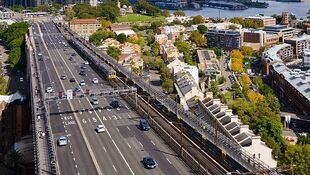
One of a number of freeways which passes through Kalibuug
Kalistan has a well maintained system of freeways (limited access highways) throughout both Ananto and the Mainland, which are maintained and funded by the federal government. Highways in the Ananto system are given a A# classification, while highways on the mainland are given a K# classification. The federal government also maintains a network of local highways, given a B# classification, while states maintain smaller highways (C#), and districts maintain important local roads (D#). In the case of A, K, and B highways, numbering is ordered with all north-south highways being odd numbered and increasing from east to west, while east-west highways are even numbered, and increase the farther south they are.
Kalistan also maintains a free, publicly funded rail system throughout both parts of the country, which operates on privately owned track, often in competition with private rail services.
There is no ground transportation connection between Ananto and the rest of Kalistan, so there is a large industry of sea transportation services between them. Following the National Ferry Service bill (February 4054), there is now a publicly maintained ferry service between Ananto and Kalistan in addition to the many private services which operate.
Technology
Kalistan is one of the most technologically advanced nations in Terra, notably in astronomy, electronics, and biotechnology. There are numerous cases throughout Kalistani history of cloning, brains-in-jars, brains-copied-into-computers, etc. More notably, Kalistan was responsible for the first space program focusing on landing on a moon, and as a result the discovery of both of Terra's moons, Luna Viridia and Luna Alba. Kalistan was also home to one of the first computers in the early 20th century.
Demographics
Ethnic groups
The ethnic group in Kalistan is the Kalistani people. It maintains influences from various groups across Terra, most notably Luthori, Pensios, Enskalan, Istalian, and most recently, Canrillaise who are recently arrivals from Lourenne.
Language
Religion
Culture
Kalistan has a rich cultural history. The primary focus of Kalistani culture is music and film production, much of which is heavily influenced by the pervasive and ubiquitous drug use in Kalistan. Significant cultural features in Kalistan are in well publicized and attended Concert festivals (such as GanJam, a cultural atmosphere conducive to development and synthesis of new styles of music, "concert films", and a vibrant record industry. Kalistani Culture is often mediated by the non-profit television and radio cooperative known as "Kalistani Radio and Television Network', as well as independent press agencies, most notably the Kalistani Republic and Izquierda newspapers, and Radio Kaliburg, which is a propaganda station that broadcasts over shortwave frequencies.
Art
Kalistani art is a fusion of diverse styles and is often experimental.
Music

Louisie Sue and Dave, Kalistani electronica pioneers
Owing to the vast array of influences present in Kalistani culture as a whole, all kinds of different music can be found in parts of the country. In modern times, though, Kalistan has been a major contributor to the development of genres such as Alternative rock, hip-hop, Reggae, Electronica, Retro-Futurism, dub, ska and funk music which has dominated the domestic charts and popular culture. The GanJam festival is one of the largest of its type in Terra.
Cuisine
The cuisine in Kalistan is influenced by the traditional crops grown in the country.
Sport
Demolition Derby was the national sport in Kalistan for most of the country's history.
Naming Conventions
Names in Kalistan can be made up of any form of the names from the cultures listed above. Most commonly, names may originate in any culture in Terra. Following the establishment of the Republic, names commonly take the form of Given Name, Family Name. Occasionally, a middle name is added, but this is not as frequent as the above form.
Equally likely as not, a last name will consist of a hyphenated form, such as Vernon-Stuart, for example. In this case, the first of the two names is the commonly used last name, while the second part of the hyphenation is frequently dropped in all but official usage. For example, David Vernon-Stuart is most often just referred to as "David Vernon", though he will sign official documents and contracts with his full name "David Vernon-Stuart." Hyphenation frequently represents the desire to reflect relationship with a large or wellknown family in Kalistan.
Bennots is a typical example: Names can either be paternal or maternal, as spouses do not often change their last name when they marry, but when the name is hyphenated, the first name of the set usually represents the closer relative, while the second represents a more distant relative. For example: Bennots-Savoy will suggest that at least one of the individual's parents was named Bennots, while another came from the family of Savoy. If it is switched, in the case of Savoy-Bennots, the person's parents were named Savoy, but Bennots, being the more famous name, belonged to a grandfather or great grandfather and has since been lost direct inheritance, but retained by hyphenation.
This naming custom was derived from the traditional Kalistani naming customs, which were infinitely more complicated. In earlier times, especially before the abolition of the Empire, all Kalistani names had high and low forms. The high form of the name had a hyphenated first name, a middle name, and a hyphenated last name. For example, John-Kumar Ivan LeBlanc-Rodriguez. The low form of the same name used the first part of the first name and the first part of the last name, so the same person using the low form of his name would be John LeBlanc. If a middle name was used as well in the low form it would be the middle name from the high form, not the second half of the hyphenated name, John Ivan LeBlanc.
Previously, before naming was simplified, the Low Form was most commonly used, due to the perceived pretension of the High Form. The exception was a hyphenated last name with -Ananto or -Reynolds as the second part. In this case the full last name was a non-divisible whole as "-Ananto" or "-Reynolds" was considered a mark of (normally self-claimed) nobility. For example: Marisol-Topaz Elizabetta Bjornsdattir-Ananto in low form would be Marisol Bjornsdattir-Ananto. "Bennots" and "Carrangus" were Republican dynastic family names which came to prominence before the end of this old tradition, and therefore are still often used by Kalistani politicians and other major actors in Kalistani society, but were associated specifically with the Republic, and the Socialist Party.
| Kalistan articles | ||
| History | Jorge I of Ananto | Ananto War | Kalistan/Gaduridos War | Crisis of 2342 | Reynoldia Crisis | |
| Geography | Ananto | Neveras | Suldanor | Odufaray | Vrassa | Maps
| |
| Politics | Government | National Assembly | Political parties | President | Ethical Socialism | Introduction | Constitutional Court | |
| Demographics | Ethnic Groups: Kalistani | Mu-Tze | Anantonese Religion: Society of Brethren | Akalism | Bishopal Church | |
| Culture | Languages | Reggae | Retro-Futurism | Floob | House Ananto | |
| Economy | Big Three | Corporations | Divestment | Ruble | Treacle | |
| Nat. Ind. | ODEN | KALNAPECO | KALNAFERCO | KALMILINCO | KALNATEXCO | KALNAMOCO | Republican National Bank | |
| Nations of Seleya | ||
| Sovereign states | Aldegar - Alduria - Baltusia - Gaduridos - Indrala - Kalistan - Kanjor - Likatonia - Lodamun - Mordusia - Rildanor - Saridan - Tukarali - Valruzia | |



